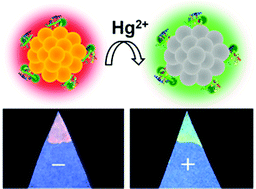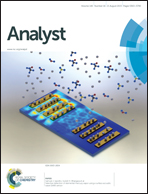Terbium(iii)/gold nanocluster conjugates: the development of a novel ratiometric fluorescent probe for mercury(ii) and a paper-based visual sensor†
Abstract
In this work, a novel ratiometric fluorescent probe was developed for rapid, highly accurate, sensitive and selective detection of mercury(II) (Hg2+) based on terbium(III)/gold nanocluster conjugates (Tb3+/BSA–AuNCs), in which bovine serum albumin capped gold nanoclusters (BSA–AuNCs) acted as the signal indicator and terbium(III) (Tb3+) was used as the build-in reference. Our proposed ratiometric fluorescent probe exhibited unique specificity toward Hg2+ against other common environmentally and biologically important metal ions, and had high accuracy and sensitivity with a low detection limit of 1 nM. In addition, our proposed probe was effectively employed to detect Hg2+ in the biological samples from the artificial Hg2+-infected rats. More significantly, an appealing paper-based visual sensor for Hg2+ was designed by using filter paper embedded with Tb3+/BSA–AuNC conjugates, and we have further demonstrated its feasibility for facile fluorescent sensing of Hg2+ in a visual format, in which only a handheld UV lamp is used. In the presence of Hg2+, the paper-based visual sensor, illuminated by a handheld UV lamp, would undergo a distinct fluorescence color change from red to green, which can be readily observed with naked eyes even in trace Hg2+ concentrations. The Tb3+/BSA–AuNC-derived paper-based visual sensor is cost-effective, portable, disposable and easy-to-use. This work unveiled a facile approach for accurate, sensitive and selective measuring of Hg2+ with self-calibration.



 Please wait while we load your content...
Please wait while we load your content...